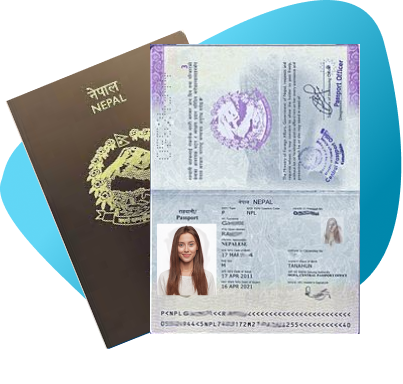E-Passports are becoming increasingly vital for international travelers, and Nepal has embraced this technology to enhance security and streamline border control. An E-Passport contains biometric data, including the passport holder’s photograph, fingerprints, and other personal details, embedded within a secure chip. In Nepal, the Ministry of Foreign Affairs issues both Standard and E-Passports, with E-Passport applications requiring the possession of a Standard Passport.
Table of Contents
1. Introduction to E-Passport in Nepal
2. Governing Laws for Passports in Nepal
3. Step-by-Step Process for E-Passport Application
1. Pre-Enrollment Application
2. Scheduling an Appointment at the Embassy
3. In-Person Attendance at the Embassy
4. Examination and Passport Processing
5. Collecting the E-Passport
4. Required Documents for E-Passport
5. Processing Time and Cost of Nepal E-Passport
6. Frequently Asked Questions (FAQs)
7. Conclusion
1. Introduction to E-Passport in Nepal
An E-Passport, or biometric passport, is a form of travel document embedded with an electronic chip that stores key biometric information such as fingerprints, facial recognition data, and more. In Nepal, both E-Passports and Standard Passports are issued, but the E-Passport offers greater security and is increasingly becoming the global standard.
2. Governing Laws for Passports in Nepal
E-Passports in Nepal are governed by the ‘Passport Act 2019’ and ‘Passport Regulations 2020’. These laws regulate the acquisition, renewal, and recovery of both standard and electronic passports. The application for an E-Passport follows stringent security protocols to protect the integrity of personal data and prevent fraud.
3. Step-by-Step Process for E-Passport Application
3.1 Pre-Enrollment Application
Before applying for an E-Passport, applicants must have a Standard Passport. The application begins with the online pre-enrollment process, where the applicant provides personal details and uploads scanned copies of their ‘Nepalese Citizenship Certificate’ and ‘Passport’. This can be done through the Department of Passport’s portal.
3.2 Scheduling an Appointment at the Embassy
Once the pre-enrollment is complete, applicants will be prompted to schedule an appointment at the nearest Nepalese Embassy or Consulate. The appointment confirmation will specify the date and time for an in-person visit.
3.3 In-Person Attendance at the Embassy
During the appointment, the applicant must appear in person with the required documentation, including the original passport, visa, Nepalese citizenship proof, and a hard copy of the application form. Biometric data—such as fingerprints, a photograph, and a signature—will be collected during this visit.
3.4 Examination and Passport Processing
Following the biometric submission, the Embassy or Consulate conducts an examination to ensure all submitted documents and data are valid. The processing time for an E-Passport usually ranges from 30 to 45 days. This period allows the embassy to perform thorough diligence before issuing the passport.
3.5 Collecting the E-Passport
Once the E-Passport is ready, the applicant will be notified and can collect it from the embassy or consulate where the application was processed.
4. Required Documents for E-Passport
To apply for an E-Passport in Nepal, the following documents are necessary:
– Front and back pages of the Nepalese Citizenship Certificate
– Standard Passport (original)
– Valid Visa (if applicable)
– A printed copy of the online application form
5. Processing Time and Cost of Nepal E-Passport
The processing time for a Nepalese E-Passport typically takes between 6 to 8 weeks, depending on the embassy or consulate’s workload and other factors. The cost for the E-Passport varies based on the number of pages required:
– 34-page passport: USD 150
– 66-page passport: USD 200
6. Frequently Asked Questions (FAQs)
Q: What is the difference between an E-Passport and a Standard Passport?
An E-Passport contains biometric information embedded in a chip, providing additional security and ease of use for international travel, whereas a Standard Passport does not include this technology.
Q: How long does it take to get an E-Passport in Nepal?
It generally takes 6 to 8 weeks to process an E-Passport in Nepal.
Q: What documents are needed to apply for an E-Passport?
You will need your Nepalese Citizenship Certificate, Standard Passport, valid visa, and a printed copy of the online application form.
Q: Can I apply for an E-Passport without a Standard Passport?
No, you must possess a Standard Passport before applying for an E-Passport.
Q: Are Non-Resident Nepali (NRN) cardholders eligible to apply for a Nepali passport, and what are the alternatives if they cannot?
No, Non-Resident Nepali (NRN) cardholders are not eligible to apply for a regular Nepali passport. According to the Nepali Citizenship Act and the NRN Act, NRNs are typically individuals of Nepali origin who hold foreign citizenship or residency, meaning they no longer have Nepali citizenship. Since Nepali passports are issued only to Nepali citizens, an NRN cannot apply for a Nepali passport if they hold citizenship in another country.
However, NRNs can apply for an NRN Identity Card, which provides certain benefits, such as the ability to own property in Nepal, stay longer in the country without a visa, and enjoy other rights similar to Nepali citizens, but this is not a substitute for a Nepali passport.
7. Conclusion
The E-Passport offers enhanced security, speed, and ease of travel for Nepalese citizens. Governed by the Passport Act 2019 and Passport Regulations 2020, it has a structured process involving online pre-enrollment, in-person biometric verification, and embassy examination. Though the process takes about 6 to 8 weeks, the benefits of having an E-Passport make it a worthwhile investment for frequent travelers.
By following the correct steps and ensuring you have all required documents, obtaining an E-Passport in Nepal is a straightforward process that aligns with global passport standards.



